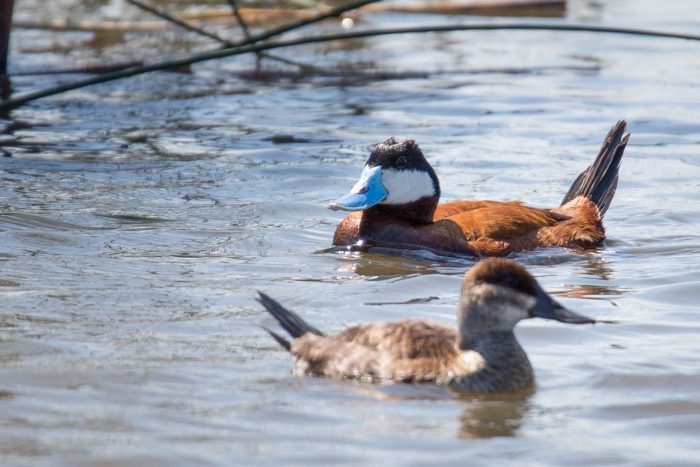Ruddy Duck
Oxyura jamaicensis
The ruddy duck is a small, chubby diving duck that visits the Chesapeake Bay and its rivers, marshes and freshwater lakes from autumn through spring.
This section shows one large critter image at a time. Use the thumbnails that follow to select a specific image to display here.

This gallery contains a grid of small thumbnails. Selecting a thumbnail will change the main image in the preceding section.
Appearance
The ruddy duck has a large head with a wide gray bill and a short, thick neck. Its long, stiff tail is often held straight up in the air. Its legs are set far back on its body. Males are dull brown in autumn, turning grayish-brown like females in winter. In summer, when ruddy ducks are not found in the Chesapeake Bay region, males have a chestnut body and a blue bill. Males have white cheeks and a black “cap” on their head, while females have a dark, smudge-like line across their cheek. The ruddy duck grows to 16 inches with a wingspan of 23 inches.
Feeding
Ruddy ducks feed on bay grasses such as pondweeds and wild celery, but will also eat insects, mollusks and crustaceans in vegetated areas. They dive to find prey.
Predators
Adults may be preyed upon by minks, hawks, owls and red foxes. Humans also hunt ruddy ducks.
Flight
Ruddy ducks take off by running and pattering across the water’s surface. Their wings beat very rapidly while flying. They can be identified in flight by their dark wings, white cheeks (on males) and stiff tail.
Voice
Usually silent in winter, courting males produce ticking and clapping sounds by pressing its bill against its breast.
Reproduction and life cycle
The ruddy duck does not breed in the Chesapeake Bay region. Breeding occurs in spring and summer in the Prairie Pothole region of the Midwest and southern Canada. To attract a mate, males go through an extravagant courtship ritual that includes swimming around a female, making several calls, and running across the water’s surface. Ruddy ducks can live as long as 13 years, but rarely live longer than two to three years.
Did you know?
- Ruddy ducks are one of the smallest ducks found in the Chesapeake Bay region. Even though they are small, they lay some of the largest eggs of any duck in the world.
- When alarmed, ruddy ducks dive underwater rather than flying away.
- Ruddy ducks are excellent swimmers. They use their long, stiff tail as a rudder to move underwater. However, they are extremely clumsy on land.
Sources and additional information
- Life in the Chesapeake Bay by Alice Jane Lippson and Robert L. Lippson
- Chesapeake Bay: Nature of the Estuary, A Field Guide by Christopher P. White
- Animal Diversity Web: Oxyura jamaicensis – University of Michigan Museum of Zoology
- Waterfowl ID: Ruddy Duck – Ducks Unlimited
- Ruddy Duck – The Cornell Lab of Ornithology
